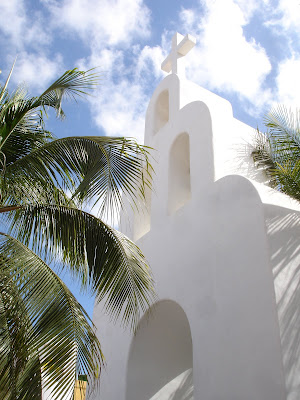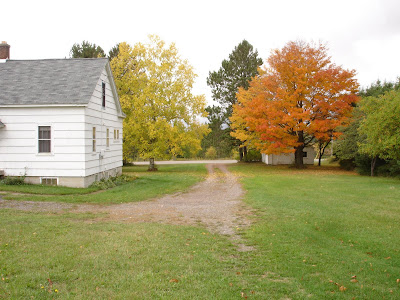I keep getting letters from
Garden Design warning me to renew. Each letter over the weeks escalates in urgency and makes grander and more generous offers. I think I’m up to 3 years for the price of one by now. No matter how they plead, whether with fear tactics, or enticements I can’t help but refuse.
Not that I don’t find
Garden Design a beautiful magazine full of inspiration. I just have so many other things to read. “Read” is the operative word here. I don’t read Garden Design. I flip through. I pause here and there, even at ads. I read a caption, a head line...
Okay, I read
Garden Design. I even read a whole article in the November/ December issue. “Your last issue.” Again!?
The article, “Jack Frost: Master Gardener”, was written by
Valerie Easton a local garden columnist and author. I feel the same sort of triumph that Val feels when she wrote: “Only after a killing frost puts the garden decidedly to bed do I have guilt-free time to read a novel or go to the movies.”
Well, frost of any kind has been late in coming this year, unnervingly so. Usually out here in the valley we have a killing frost by mid-October long before Seattle and the rest of the Puget Sound Basin. I look forward to that frost exactly for the reason Ms. Easton states. I want to be able to turn my back on the garden guiltlessly.
I am always looking for reasons to snub the garden, or in more enlightened moments “let it go”, even in spring and summer. But it’s hard to let go when the weather isn’t cooperating. In August I gave up on ever seeing cucumbers, the summer was so cool they barely came into bloom. But last Friday firmly Fall and well into November I picked our last cucumber. we do not live in Mexico you understand, or even southern California. We’re only a little over 100 miles form the Canadian border.
Mid-week when the temperatures reached upward toward the mid-70s making bulb planting a delight I was feeling a bit anxious about where this was all going. The weekend before last the river, filling with heavy rain, was nudging toward flood stage. Luckily it never got there, though it did spill in places out onto the road. I had begun the settled-in season during those rains, opened a book and began to read without an end point in sight. It was a guilty pleasure. Though it was wet it was still warm enough to get some plants in the ground. That’s the problem with doing this for a living, there is an unstoppable stream of plants coming on to the property. But my clock was ticking already to a different drummer, sorry for that mixed metaphor, but you understand the ticking was drum-loud. I needed to crash, to go into reading, writing, baking, the general preoccupations that make ignoring the garden less guilt-ridden.
I was looking forward to a dismal weekend, where lethargy finally won and I could finish reading “Sukkwan Island” a startlingly excellent novella by
David Vann. On page 103 when the two protagonists , a father and a son “... both looked into the sky, into the grayness that had no depth or end, and then they went inside” sounded like the perfect weekend to me. I’m sure those of you who were stuck in an office on Tuesday and Wednesday when summer made a guest appearance --I even tanned a bit-- would disagree with me.
Yet we both got what we needed.
Saturday offered all manner of glum weather, rain, wind, clouds. Hardly miserable, but “miserable” I said none-the-less, pulled the fleece blanket over my pajama’d body and went on reading. I finished “Sukkwan Island” and headed back into Roger Deakin’s
Wildwood:A Journey Through Trees. I started it about a year and a half ago and have been savoring the series of essays on the cinematographer’s relationship to trees and wood, and the fascinating people and places this interest found for him. I’ve been reading Deakin’s rich humble prose in chunks between other books. And I know it will be one of those books I’ll return to over the years like Annie Dillard’s
For the Time Being. I finished Deakin before bed time and began assembling a stack of back issues for my Sunday reading. I was getting into this lazy thing. And what could be more lazy than reading magazines all day? Well, I guess, napping. But I’m sure that would happen between
Gardens Illustrated and
Pacific Horticulture.
You see, there are getting to be way too many periodicals in out house between my horticultural subscriptions and Michael’s literary ones we probably get upward to 10 magazines a month. I usually try to read them all in January when the weather is really bad and it’s time to do a little new year purging. But I was looking forward to getting an early start and maybe using my January downtime for something productive.
Then the sun came out.
It was Sunday and it was sunny. It was what all you office workers were hoping for and it dashed my lazy hopes of wallowing in the glossy world of magazines.
Oh,well, I could have just lied there basking like the cat. But you don’t know me if you think I could do that. I would take a 101 degree day, or a 101 degree fever for me to just lie around on a sunny day.
So I went for a walk.
As I walked I called my dear friend Joseph who lives back in Philadelphia. I didn’t really want to walk alone and Michael was busy writing. Joseph and I always share weather reports for the first few minutes of our calls. Who’s warmer? Who’s wetter?A bit competatively, but all in fun. He almost always wins, living on the rambunctious East Coast. When I win it is when we are having a prolonged cloudy spell, weeks, months even, without sunshine.
It happens here.
But not this year. What we’re having this year is prolonged instability. The sunshine never stays long enough to build false hopes. The rain and gray just takes us to the edge of dismal and then retreats. So when a Sunday is sunny and your plans are for lying on the sofa with stacks of back issues, because after all it is November and it should be at least cloudy if not raining, you change your plans and go out for a walk.
It was good to do some foot work assessment of the valley and the progress of fall. So after I said good-bye to Joseph I kept walking to
Tolt MacDonald Park.
The river was no longer frighteningly high. Yet the “pond” is back in our neighbors’ horse paddock. The drainage ditches along the road which cuts through the swamp are engorged. Frogs scuttled across their glassy black surfaces as if winter was an afterthought instead of a foreboding. The prognosticators, those generators of doom and gloom are predicting a walloping good winter this year. Wet, cold and snowy I keep hearing. Then why is November nearly as pleasant as July?
The calm before the storm?
At this time of year, the flood season, when the river becomes threatening, I wonder sometimes why I gravitated to this watery place. Even if it only closes the north end of the road and I have to take the long way out it feels like more than an inconvenience. But I have an affinity for watery places. When Michael and I were traveling through Rajistan a few years ago I was constantly on the look out for sources for water. How do all these people live with such little water, and such dirty water at that? I am increasingly uncomfortable when I visit my sister in Arizona. I have watched Phoenix mushroom out into the desert at an alarming rate and I can’t help but ask, “Where is the water?”
“ I wondered again,” writes Roger Deakin about his travels to the arid landscapes of Kyrgyzstan, “ how it is that trees are able to feel their way towards water, even when their roots have to travel some distance to reach it. By which process do they sense its nearness? Those little roots, which do all the work of absorbing water, may just be antennae of a kind.” Like roots the search for water is innately deep in me. I feel more comfortable knowing its near. Like a willow on a river bank dangling its toes.
It was like being home being able to just walk through my neighborhood.
And the walk was remarkably rejuvenating, probably much more so then a slumped afternoon on the couch with a stack of magazines. There were birds and birders on the road, bikers, roller-skiers and Sunday-drivers-- some of them were actually driving like it was Friday afternoon-- their were families in the park, dog-walkers and dogs, joggers and me stopped on a log to take notes:
“ When I woke before dawn I opened the door to let the black cat in. At first I sniffed the darkness. Then I drew it in deeply through both nostrils. There was a faint sweetness to the air that one might misread as the first frost. It was clear enough. But not cold enough. By mid-day I basked on a log in the woods, where sun rays piercing the canopy were warm, released some tensions still lingering from the week. I had wanted a gloomy Sunday, an excuse to retreat from the world, but I was totally glad it wasn’t delivered.
“You can’t always get what you want,
But if you try sometimes you just might find,
you get what you need.”"























































